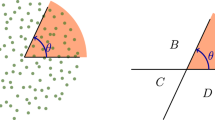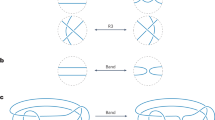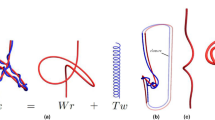Abstract
ULAM1 reports that “there was another problem which Fermi wanted to study but which we somehow never came to formulate well or to work on. He said one day, ‘it would be interesting to do something purely kinematical. Imagine a chain consisting of very many links, rigid, but free to rotate around each other. It would be curious to see what shapes the chain would assume when it was thrown on a table, by studying purely the effects of the initial energy and constraints, no forces’.” Synge2 posed the problem of estimating the average D̄ of the rectilinear distance D between the ends of a flexible string of length L when thrown down at random on a table. Later3 he published conceptual models and some experiments which together increased the challenge (recently restated by Kingman4): the models yielded values of D̄/L equal either to 0 or 1 unity, whereas in three experimental series by different throwers of different strings, the values obtained were 0.32 (100 throws), 0.34 (50 throws) and 0.38 (60 throws). (Only for the last of these was the value of D̄2/L2 also recorded, at 0.18.) Synge wrote3: “the agreement of the results is rather striking and one might hope to explain the numerical value (say 1/3) on theoretical grounds....I hoped that someone would suggest a way of treating directly a system with an infinite number of degrees of freedom, but perhaps no such way exists”. Here we propose a solution along the desired lines by kinematical means.
This is a preview of subscription content, access via your institution
Access options
Subscribe to this journal
Receive 51 print issues and online access
$199.00 per year
only $3.90 per issue
Buy this article
- Purchase on Springer Link
- Instant access to full article PDF
Prices may be subject to local taxes which are calculated during checkout
Similar content being viewed by others
References
Ulam, S. M. Adventures of a Mathematician, 229 (Charles Scribner's Sons, New York, 1976).
Synge, J. L. Math. Gaz. 52, 165 (1968).
Synge, J. L. Math. Gaz. 54, 250–260 (1970).
Kingman, J. F. C. Adv. appl. Probability 9, 431 (1977).
Debye, P. J. W. Topics in Chemical Physics ch. 6 (eds Prock, A. & McConkey, G. Elsevier, Amsterdam, 1962).
Author information
Authors and Affiliations
Rights and permissions
About this article
Cite this article
BASS, L., BRACKEN, A. The problem of the thrown string. Nature 275, 205–206 (1978). https://doi.org/10.1038/275205a0
Received:
Accepted:
Issue Date:
DOI: https://doi.org/10.1038/275205a0
This article is cited by
-
The problem of thrown string
Nature (1979)
-
The problem of thrown string
Nature (1979)
-
The problem of thrown string (reply)
Nature (1979)
Comments
By submitting a comment you agree to abide by our Terms and Community Guidelines. If you find something abusive or that does not comply with our terms or guidelines please flag it as inappropriate.



